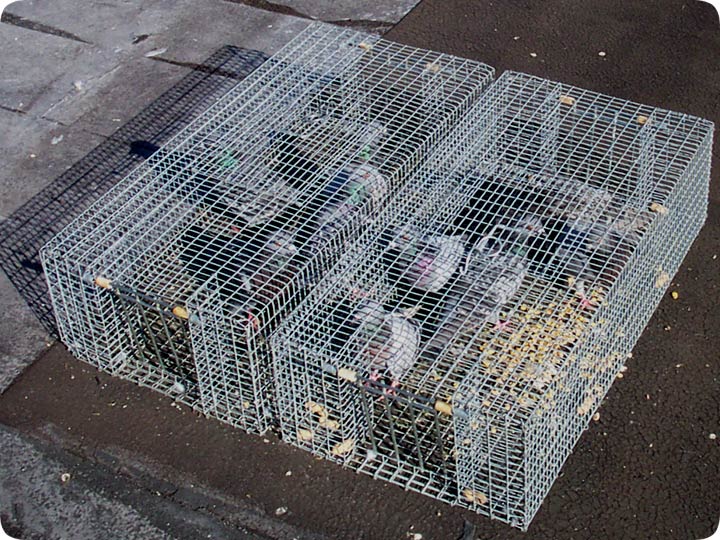-
info@aaanimalcontrol.com
Call us for help in your town
Humane Wildlife Education
Pigeon Trapping in Cages

03.14.2005 - The majority of the time, pigeon control centers around abatement practices - the installation of physical deterrents that prevent them
from roosting in undesirable areas. An example is the installation of pigeon spikes on a store sign in order to prevent them from landing on the sign. However,
at times pigeon trapping and removal is a desirable solution. For example the building may be too large in order for spike removal to be cost effective. Or
perhaps the pigeons are roosting on or in an area where spikes or other deterrents won't fit or can't be installed. If the birds are trapped and removed from
the area, then the problem is diminished.
However, trapping and removal is not a permanent solution - if an area is attractive to pigeons, then new ones will
choose to live in that area. Wildlife trapping in general is often a temporary fix. In addition, it's usually impossible to get all of the birds. Thus, the
remaining ones will stay and nest and create new birds. Still, trapping does have its place and it is useful in certain circumstances. Oftentimes, it can
be part of an overall plan to keep the pigeon population down to reasonable levels.
In order to catch pigeons in traps, set the trap in an area where the pigeons are known to congregate, and bait with seed, cracked corn, and the like. Wire the
doors of the trap open for a few days if you want to have the pigeons gain trust in the traps and food source. One interesting thing about pigeon trapping is
that pigeons are sociable and greedy - thus, one pigeon in a trap will actually attract others. So perhaps when you trap them, you'll want to leave one behind
in the trap in order to attract new ones. But don't leave any live animal stuck in a trap for too long - particularly if it's exposed to sunlight - because
that's cruel. Then, finally, I should say that pigeons can't really be relocated. They're pretty damn good at navigating their way home. So pigeon stew is
really the only answer. Good luck with your pigeon trapping!
Do it yourself: Visit my How To Get Rid of Pigeons page for tips and advice.
Get professional help: Visit my Nationwide Pro Directory of wildlife removal experts.
For more wildlife stories, click my Wildlife Blog
or click my below banner to hire a local trapper.
There are several methods that you can use to eliminate pigeons, but most people prefer using cages because this method is humane and relatively easy to carry out. Pigeons are very annoying pests to have around your yard or house, and eliminating them can be quite a task.
If you want to use cage traps to eliminate pigeons from your yard or house, you must trap them properly. To do this, the trap cage you decide to use must be effective in catching the pigeons. Therefore, we have listed some types of traps that you can use.<
Funnel-door cages: These have a funnel door that allows the pigeon to enter into the cage. The funnel door has this shape because that way, the pigeon can easily enter into the enclosure but cannot go out. This door is the only entrance that is available to the pigeon, and the cage traps the pigeons until you are ready to release them into the wild or kill them.
One-way door cages: These only allow the pigeons to come in after you have set it. Pigeons cannot exit the trap until you are ready to release them. This is quite different from the funnel-door cages in shape, but they both function the same way.
Two-way door cages: These are suitable for large open areas where exclusion will be impossible. This cage, when you have set it, allows the pigeon to come and not go back out, it has two doors because it covers a large area. To do this, you may have to feed them for five to seven days, to keep the pigeons inside the cage alive and to attract other pigeons to the cage.
Using a trap is a humane way of getting rid of your pigeon infestation problem, but the downside to this is that you will also have to decide what happens to the pigeons that you have trapped. You may want to relocate the pigeons to other regions where they will not be a nuisance to others. However, this has not worked well in the past because pigeons always seem to find their way back home, which is very frustrating.
After trapping the pigeons successfully, you can call the wildlife control center in your area to remove them from your yard or euthanize them. These professionals have the training required to handle wildlife and pests and also have a license and permit to euthanize animals when it is necessary.
It would help if you also took precautions when handling the pigeons. Although they are quite harmless birds, they transmit many disease-causing agents to humans and other animals, and so it would be a terrible idea to handle them without gloves or protective clothing.
You should also camouflage the trap to make the pigeons less cautious when they approach the trap cage, and you should also place the trap in an area that makes it blend in with the environment. At any point, you can employ the service of a professional, and they will guide you on how to use a cage to trap pigeons effectively.




















